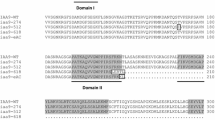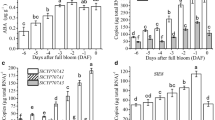Abstract
In flowering plants, fruit dehiscence enables seed dispersal. Here we report that ntt-3D, an activation tagged allele of NO TRANSMITTING TRACT (NTT), caused a failure of fruit dehiscence in Arabidopsis. We identified ntt-3D, in which the 35S enhancer was inserted adjacent to AT3G-57670, from our activation tagged mutant library. ntt-3D mutants showed serrated leaves, short siliques, and indehiscence phenotypes. NTT-overexpressing plants largely phenocopied the ntt-3D plants. As the proximate cause of the indehiscence, ntt-3D plants exhibited a near absence of valve margin and lignified endocarp b layer in the carpel. In addition, the replum was enlarged in ntt-3D mutants. NTT expression reached a peak in flowers at stage 11 and gradually decreased thereafter and pNTT::GUS expression was mainly observed in the replum, indicating a potential role in fruit patterning. NTT:GFP localized in the nucleus and cytoplasm. FRUITFULL (FUL) expression was downregulated in ntt-3D mutants and ntt-3D suppressed upregulation of FUL in replumless mutants. These results indicate that NTT suppresses FUL, indicating a potential role in patterning of the silique. In seed crops, a reduction in pod dehiscence can increase yield by decreasing seed dispersal; therefore, our results may prove useful as a basis to improve crop yield.
Similar content being viewed by others
References
Ahn, J.H., Kim, J., Yoo, S.J., Yoo, S.Y., Roh, H., Choi, J.H., Choi, M.S., Chung, K.S., Han, E.J., and Hong, S.M. (2007). Isolation of 151 mutants that have developmental defects from T-DNA tagging. Plant Cell Physiol. 48, 169–178.
Alonso, J.M., Stepanova, A.N., Leisse, T.J., Kim, C.J., Chen, H., Shinn, P., Stevenson, D.K., Zimmerman, J., Barajas, P., Cheuk, R., et al. (2003). Genome-wide insertional mutagenesis of Arabidopsis thaliana. Science 301, 653–657.
Alonso-Cantabrana, H., Ripoll, J.J., Ochando, I., Vera, A., Ferrandiz, C., and Martinez-Laborda, A. (2007). Common regulatory networks in leaf and fruit patterning revealed by mutations in the Arabidopsis ASYMMETRIC LEAVES1 gene. Development 134, 2663–2671.
Crawford, B.C.W., Ditta, G., and Yanofsky, M.F. (2007). The NTT gene is required for transmitting-tract development in carpels of Arabidopsis thaliana. Curr. Biol. 17, 1101–1108.
Dinneny, J.R., and Yanofsky, M.F. (2005). Drawing lines and borders: how the dehiscent fruit of Arabidopsis is patterned. Bioessays 27, 42–49.
Englbrecht, C.C., Schoof, H., and Bohm, S. (2004). Conservation, diversification and expansion of C2H2 zinc finger proteins in the Arabidopsis thaliana genome. BMC Genomics 5, 39.
Ferrandiz, C., Liljegren, S.J., and Yanofsky, M.F. (2000). Negative regulation of the SHATTERPROOF genes by FRUITFULL during Arabidopsis fruit development. Science 289, 436–438.
Gonzalez-Reig, S., Ripoll, J.J., Vera, A., Yanofsky, M.F., and Martinez-Laborda, A. (2012). Antagonistic gene activities determine the formation of pattern elements along the mediolateral axis of the Arabidopsis fruit. PLoS Genet. 8, e1003020.
Gu, Q., Ferrandiz, C., Yanofsky, M.F., and Martienssen, R. (1998). The FRUITFULL MADS-box gene mediates cell differentiation during Arabidopsis fruit development. Development 125, 1509–1517.
Hong, S.M., Bahn, S.C., Lyu, A., Jung, H.S., and Ahn, J.H. (2010). Identification and testing of superior reference genes for a starting pool of transcript normalization in Arabidopsis. Plant Cell Physiol. 51, 1694–1706.
Kim, W., Ahn, H.J., Chiou, T.J., and Ahn, J.H. (2011). The role of the miR399-PHO2 module in the regulation of flowering time in response to different ambient temperatures in Arabidopsis thaliana. Mol. Cells 32, 83–88.
Liljegren, S.J., Ditta, G.S., Eshed, Y., Savidge, B., Bowman, J.L., and Yanofsky, M.F. (2000). SHATTERPROOF MADS-box genes control seed dispersal in Arabidopsis. Nature 404, 766–770.
Liljegren, S.J., Roeder, A.H.K., Kempin, S.A., Gremski, K., Ostergaard, L., Guimil, S., Reyes, D.K., and Yanofsky, M.F. (2004). Control of fruit patterning in Arabidopsis by INDEHISCENT. Cell 116, 843–853.
Meakin, P.J., and Roberts, J.A. (1990a). Dehiscence of fruit in oilseed rape (Brassica napus L.): 1. Anatomy of pod dehiscence. J. Exp. Bot. 41, 995–1002.
Meakin, P.J., and Roberts, J.A. (1990b). Dehiscence of fruit in oilseed rape (Brassica napus L.): 2. The role of cell wall degrading enzymes and ethylene. J. Exp. Bot. 41, 1003–1010.
Ostergaard, L. (2009). Don’t ‘leaf’ now. The making of a fruit. Curr. Opin. Plant Biol. 12, 36–41.
Rajani, S., and Sundaresan, V. (2001). The Arabidopsis myc/bHLH gene ALCATRAZ enables cell separation in fruit dehiscence. Curr. Biol. 11, 1914–1922.
Ramakers, C., Ruijter, J.M., Deprez, R.H., and Moorman, A.F. (2003). Assumption-free analysis of quantitative real-time polymerase chain reaction (PCR) data. Neurosci. Lett. 339, 62–66.
Roeder, A.H.K., Ferrandiz, C., and Yanofsky, M.F. (2003). The role of the REPLUMLESS homeodomain protein in patterning the Arabidopsis fruit. Curr. Biol. 13, 1630–1635.
Romera-Branchat, M., Ripoll, J.J., Yanofsky, M.F., and Pelaz, S. (2013). The WOX13 homeobox gene promotes replum formation in the Arabidopsis thaliana fruit. Plant J. 73, 37–49.
Sagasser, M., Lu, G.H., Hahlbrock, K., and Weisshaar, B. (2002). A. thaliana TRANSPARENT TESTA 1 is involved in seed coat development and defines the WIP subfamily of plant zinc finger proteins. Genes Dev. 16, 138–149.
Schmid, M., Uhlenhaut, N.H., Godard, F., Demar, M., Bressan, R., Weigel, D., and Lohmann, J.U. (2003). Dissection of floral induction pathways using global expression analysis. Development 130, 6001–6012.
Smyth, D.R., Bowman, J.L., and Meyerowitz, E.M. (1990). Early flower development in Arabidopsis. Plant Cell 2, 755–767.
Spence, J., Vercher, Y., Gates, P., and Harris, N. (1996). ‘Pod shatter’ in Arabidopsis thaliana, Brassica napus and B. juncea. J. Microsc. 181, 195–203.
Udvardi, M.K., Czechowski, T., and Scheible, W.R. (2008). Eleven golden rules of quantitative RT-PCR. Plant Cell 20, 1736–1737.
Vandesompele, J., De Preter, K., Pattyn, F., Poppe, B., Van Roy, N., De Paepe, A., and Speleman, F. (2002). Accurate normalization of real-time quantitative RT-PCR data by geometric averaging of multiple internal control genes. Genome Biol. 3, research 0034.0031-0034.0011.
Weigel, D., Ahn, J.H., Blazquez, M.A., Borevitz, J.O., Christensen, S.K., Fankhauser, C., Ferrandiz, C., Kardailsky, I., Malancharuvil, E.J., Neff, M.M., et al. (2000). Activation tagging in Arabidopsis. Plant Physiol. 122, 1003–1013.
Yoo, S.K., Hong, S.M., Lee, J.S., and Ahn, J.H. (2011). A genetic screen for leaf movement mutants identifies a potential role for AGAMOUS-LIKE 6 (AGL6) in circadian-clock control. Mol. Cells 31, 281–287.
Author information
Authors and Affiliations
Corresponding authors
About this article
Cite this article
Chung, K.S., Lee, J.H., Lee, J.S. et al. Fruit indehiscence caused by enhanced expression of NO TRANSMITTING TRACT in Arabidopsis thaliana . Mol Cells 35, 519–525 (2013). https://doi.org/10.1007/s10059-013-0030-0
Received:
Revised:
Accepted:
Published:
Issue Date:
DOI: https://doi.org/10.1007/s10059-013-0030-0




